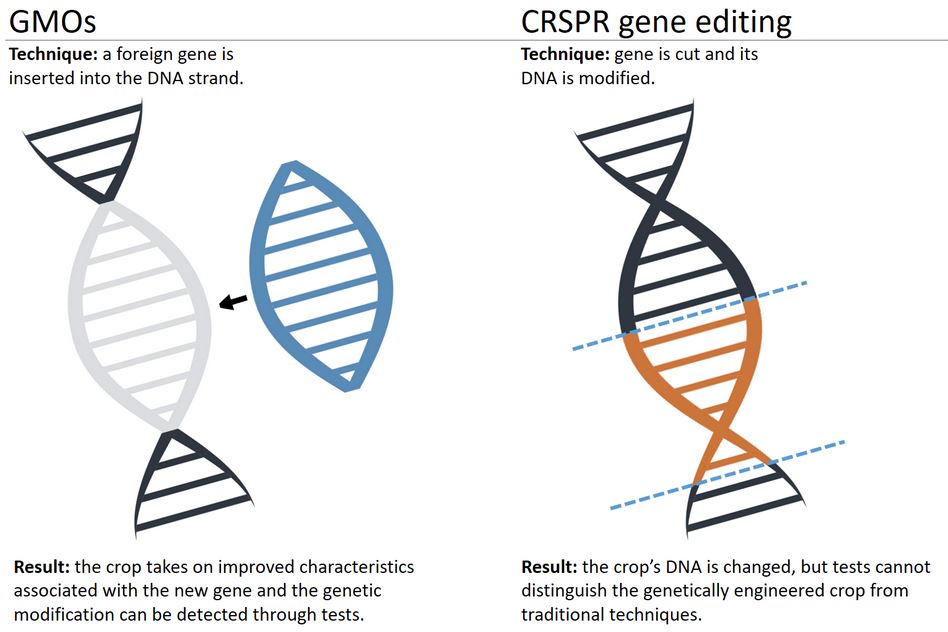Note4Students
From UPSC perspective, the following things are important :
Prelims level: Non-Transgenic Gene Editing
Mains level: Hazards of using GMO crops

The Centre is yet to decide on a research proposal from scientists which would allow plants to be genetically modified without the need for conventional transgenic technology.
What is Genome Editing?
- Genome editing (also called gene editing) is a group of technologies that give scientists the ability to change an organism’s DNA.
- These technologies allow genetic material to be added, removed, or altered at particular locations in the genome.
- Several approaches to genome editing have been developed.
Techs for Genome Editing
The core technologies now most commonly used to facilitate genome editing are
- Clustered regularly interspaced short palindromic repeats (CRISPR)- associated protein 9 (Cas9)
- Transcription activator-like effector nucleases (TALENs)
- Zinc-finger nucleases (ZFNs)
- Homing endonucleases or meganucleases
Newer technologies
- The Institute has now moved to newer technologies such as Site-Directed Nuclease (SDN) 1 and 2.
- They aim to bring precision and efficiency into the breeding process using gene-editing tools such as CRISPR, whose developers won the Nobel Prize for Chemistry in 2020.
About CRISPR
- CRISPR-Cas9 was adapted from a naturally occurring genome editing system in bacteria.
- The bacteria capture snippets of DNA from invading viruses and use them to create DNA segments known as CRISPR arrays.
- The CRISPR arrays allow the bacteria to “remember” the viruses (or closely related ones).
- If the viruses attack again, the bacteria produce RNA segments from the CRISPR arrays to target the viruses’ DNA.
- The bacteria then use Cas9 or a similar enzyme to cut the virus DNA apart, which disables the virus.
- This method is faster, cheaper, more accurate, and more efficient than other existing genome editing methods.
What is Non-Transgenic Gene Editing?
- Unlike the older GM technology which involves the introduction of foreign DNA, the new proposal involves the use of gene editing tools to directly tweak the plant’s own genes instead.
- It does not involve inserting any foreign DNA.
Use in India
- Scientists at the Indian Agricultural Research Institute (IARI) are in the process of developing resilient and high-yield rice varieties using such gene editing techniques.
- However, this proposal has been pending with the Genetic Engineering Appraisal Committee (GEAC) for almost two years.
Why need such technique?
- Similar to natural mutation: But in this case, this protein is right there in the plant, and is being changed a little bit, just as nature does through mutation.
- Faster and cheaper: It is much faster and far more precise than natural mutation or conventional breeding methods which involve trial and error and multiple breeding cycles.
- Safe for consumption: When a protein comes from an outside organism, then you need to test for safety.
- Pathbreaking: It is potentially a new Green Revolution.
No approval issues
- The SDN 1 and SDN 2 categories of genome-edited plants do not contain any foreign DNA when they are taken to the open field trials.
- The US, Canada, Australia and Japan are among the countries which have already approved the SDN 1 and 2 technologies as not akin to GM.
- So, such varieties of rice can be exported without any problem.
- The European Food Safety Authority has also submitted its opinion that these technologies do not need the same level of safety assessment as conventional GM.
UPSC 2022 countdown has begun! Get your personal guidance plan now! (Click here)
Get an IAS/IPS ranker as your 1: 1 personal mentor for UPSC 2024
